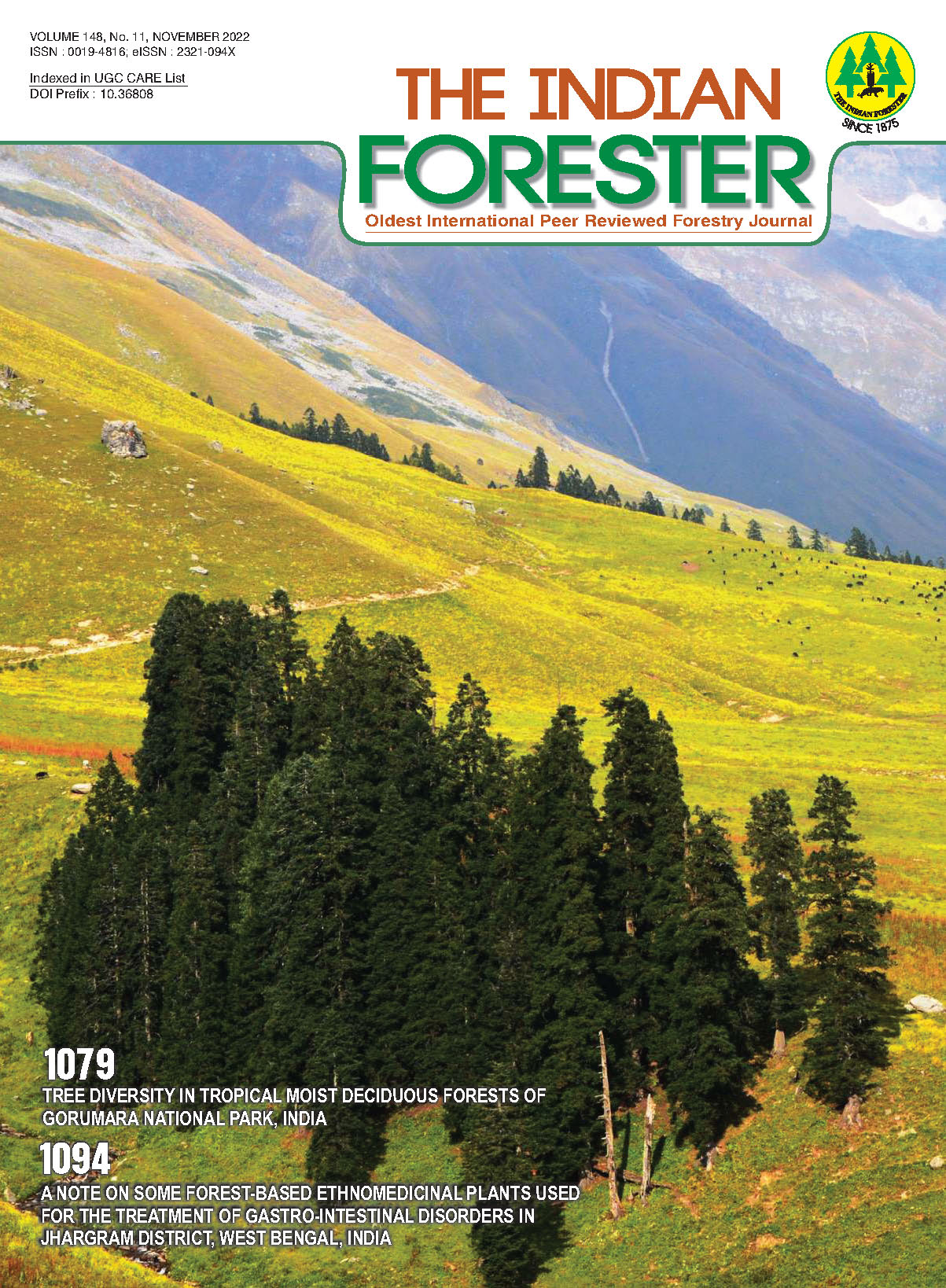Growth performance of Santalum album L. in Association with different Host species in South Gujarat Region
DOI:
https://doi.org/10.36808/if/2022/v148i11/156796Keywords:
Santalum album L., Growth Performance, Host Species, Height, Diameter and VolumeAbstract
Santalum album is conceived as one of the most precious tree species in the world. In the present investigation growth performance of sandalwood with reference to various host species has been studied on five years old plantation in moist deciduous region of southern Gujarat. Three parameters height, DBH and volume index were considered for comparing growth performance of sandalwood in association with eight host species in four replications and ten combinations for a total of 240 plants. Significant variations among all combination were statistically analyzed through oneway ANOVA test. Cajanus cajan and Cassia siamea showed most potential host species for sandalwood growth compared to other host species.References
Annapurna D., Rathore T.S. and Joshi G. (2006). Modern nursery practices in the production of quality seedlings of Indian sandalwood (S. album L.) – Stage of host requirement and screening of primary host species. Journal of Sustainable Forestry, 22: 33-55.
Aparna, Pallavi (2015). Return to scented wood. Down to Earth, 2(4): 10-14.
Bommareddy A., Brozena S., Steigerwalt J., Landis T., Hughes S., Mabry E. and Dwivedi C. (2019). Medicinal properties of alpha-santalol, a naturally occurring constituent of sandalwood oil. Natural product research, 33(4): 527-543.
Champion H.G. and Seth S.K. (1968). A Revised Survey of the Forest Types of India. The Manager of Publications, Delhi, India.
Dave K., Alsharif F.M., Islam S., Dwivedi C. and Perumal O. (2017). Chemoprevention of breast cancer by transdermal delivery of α-santalol through breast skin and mammary papilla (nipple). Pharmaceutical research, 34(9): 1897-1907.
Fox J.E.D., Doronila A.I., Barrett D.R. and Surata I.K. (1996). Desmanthus virgatus (L.) Willd. an efficient intermediate host for the parasitic species S. album L. in Timor, Indonesia. Journal of Sustainable Forestry, 3(4): 13-23.
Goswami N.B. and Tah J. (2018). White sandal (S. album L.) a precious medicinal and timber yielding plant: a short review. Plant Archives, 18(1): 1048-1056.
Jeremy L. (2017). Demand of sandalwood and its greatest threat. The Indian Economist. Krishnakumar N., Parthiban K.T. and Kanna S.U. (2018). Growth performance of sandal wood (S. album L.) (An endangered medicinal tree) progenies under nursery conditions. The Pharma Innovation, 7(5): 312.
Kumar M.K. (1994). Genetic divergence, isozyme pattern and micro-propagation studies in sandal (S. album L). M.Sc. Thesis, Tamil Nadu Agricultural University, Coimbatore.
Manavalan A. (1990). Seedling vigour and bioproductivity in woody biomass species. Ph.D. Thesis, Madurai Kamaraj University, Madurai.
Manonmani V. (1997). Investigation on seed collection, storage and germination of teak (Tectona grandis) and Sandal (S. album). Ph.D. Thesis, Tamil Nadu Agricultural University, Coimbatore,
Nagaveni H.C. and Vijayalakshmi G. (2003). Growth performance of sandal (S. album L.) with different host species. Sandalwood Research Newsletter, 18: 1- 4.
Radomiljac A.M. and McComb J.A. (1998). Nitrogen-fixing and non-nitrogen fixing woody host influences on the growth of the root hemi-parasite S. album L. In: Proceeding of conference- S a n d a l a n d i t s P r o d u c t s , ( R a d o m i l j a c , A . M . Ananthapadmanbho, H. S., Welbourn R.M. and Satyanarayan R.K. Ed.) ACIAR proceedings 84. ACIAR, Canberra.
Santha S. and Dwivedi C. (2013). α-Santalol, a skin cancer chemopreventive agent with potential to target various pathways involved in photocarcinogenesis. Photochemistry and photobiology, 89(4): 919-926.
Shankaranarayana K.H., Kumar R.G., Rajeevalochan A.N., Theagarajan K.S. and Rangaswamy C.R. (1998). Content and composition of oil from the Central and transition zones of the Sandal wood disc. Australian centre for International Agricultural Research. Proceedings of an international seminar on Sandal and its products.
Singh G. (2014). Project Concluding Report. Studies on carbon sequestration in different forest types of Rajasthan. Arid Forest Research Institute, Jodhpur, Rajasthan, India.
Surata I.K. (1995). The effect of host plants on the growth of sandalwood seedlings (S. album Linn). Sandalwood Research Newsletter, 3: 1-2.
Downloads
Downloads
Published
How to Cite
Issue
Section
License
Unless otherwise stated, copyright or similar rights in all materials presented on the site, including graphical images, are owned by Indian Forester.





